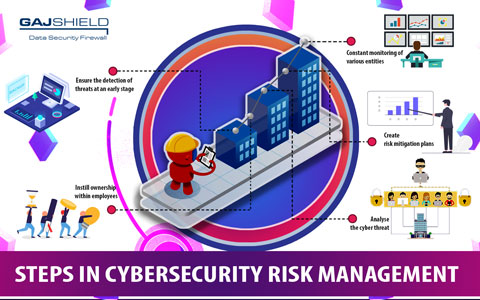Steps in cybersecurity risk management

For organisations, cybersecurity is a non-negotiable area of investment in order to protect their precious technical and financial data along with their IP content. Risks in cybersecurity can impact organisations at any point in time without warnings in advance. Such attacks and threats can be exceptionally difficult to handle once they are successfully executed by cyber criminals. Therefore, corporations must proactively manage cybersecurity risks to prevent cyber attacks. A specialised cybersecurity team in such organisations can create and regularly update a robust risk management plan. Here are the steps organisations can take while managing real-time cybersecurity risks:
a. Ensure the detection of threats at an early stage
It can be assumed that an organisation has set up a dedicated cybersecurity team and has established frameworks and reference points for all the employees and other stakeholders to follow when a cyber attack takes place. Honestly, the cybersecurity personnel must not wait for such a cyberattack to hit their data networks and completely overwhelm their servers and devices. Organisations must install and integrate proactive cybersecurity systems such as intelligent firewalls and advanced cloud security systems to nip the threat in the bud if it is detected in the early stages of a cyber attack.
b. Instill ownership within employees
Like the first step, organisations need not wait for a cyber attack to actually take place to implement this step. All the employees in the workplace must be aware of the things that are on the line if their employer is cyber attacked by hackers. As a result, they must know what steps and measures to implement at all times (regardless of whether an attack takes place or not). Examples of these steps can be as simple as locking one's laptop during lunch breaks or not sharing network login details with anybody. Managers and top-level bosses can reward employees for their diligence in this regard. Essentially, employees must feel a sense of belonging to actually care for the organisation's cybersecurity. Generally, most cyber threats can be prevented if the employees of an organisation play their part in safeguarding their employer’s data.
c. Analyse the cyber threat
Before dealing with a threat, organisations must analyse it carefully. This step ensures that companies use the right number of resources to deal with a cyber threat. Assessing a cyber threat involves knowing the consequences of letting it run unabated through the company’s networks. Analysing a potential cyber threat (or an ongoing attack) can be more challenging than dealing with its impacts. Analysing a cybersecurity risk involves a lot of data crunching and schematics. There are several types of assessment techniques available for organisations to make quantitative guesstimates regarding an attack in its early stages. To be effective, organisations must possess documented information about the various types of cyber threats and the budget and other resources to be used to counter them.
In the analysis phase, organisations must also estimate the damages incurred due to a data security attack in the future. Generally, there are three types of losses suffered by organisations whenever a cyber attack takes place:
- Operational losses are the expenses caused due to the data breach directly, such as the money needed to be spent on correcting the system damage after a cyber attack.
- Legal losses are the compensation expenses shelled out by organisations once they are dragged into court by their clients or other stakeholders whose data has been compromised via the cyber attack.
- Goodwill loss is the reputational hit that an organisation has suffered due to an attack. Social media and news channels can be particularly ruthless in destroying the reputation of beleaguered organisations during difficult times like these. While operational losses and legal expenses may be recovered within a few years, reputational losses stay on for much longer.
d. Create risk mitigation plans
After identification and analyses, organisations need to strategize to mitigate the impacts of a cyber attack. A risk-response mechanism is essential for organisations to deal with attacks when they take place. Firstly, organisations need to consider all their options regarding the mitigation process. Risk mitigation could be on a technical level or a human level. From a technical point of view, organisations can deploy end-to-end encryption of data and the installation of antivirus software on every device in the workplace. The human level involves basic cybersecurity etiquette in employees, the practice of constantly updating data security software, amongst other actions. One of the mitigation actions is having cybersecurity insurance in place. Generally, falling back on insurance is a last-ditch attempt to recoup some of the losses due to the attack. Organisations can make multiple mitigation plans for every type of cyber threat.
e. Constant monitoring of various entities
After the risk identification, analysis, and mitigation steps, organisations need to ensure that every stakeholder is closely monitored at all times. As we know, cybersecurity risks could be posed by internal as well as external drivers. This is why organisations must keep tabs on their employees, business partners, and other 'insiders'. Monitoring also includes continuous compliance with nationwide regulations regarding cybersecurity protocols. While purchasing software or devices from vendors, those purchases must be properly analysed and checked by the data security team before the organisation implements them in their daily operations. Moreover, the technology used by the cybersecurity team for detection, prevention and/or mitigation of cyber threats must be of the best quality.
Your organisation could be the victim of a cyber attack at any point in time. As specified earlier, if the cybersecurity of your organisation is not perfect, you could incur several losses and unwanted expenses. This is where Gajshield enters the fray. Our latest data security firewalls and context-aware data protection systems can protect your data networks against any kinds of threats. You can contact us to know more about our products and services.
Get In Touch With Us
Subscribe to our Newsletter
2025 © GajShield Infotech (I) Pvt. Ltd. All rights reserved.
